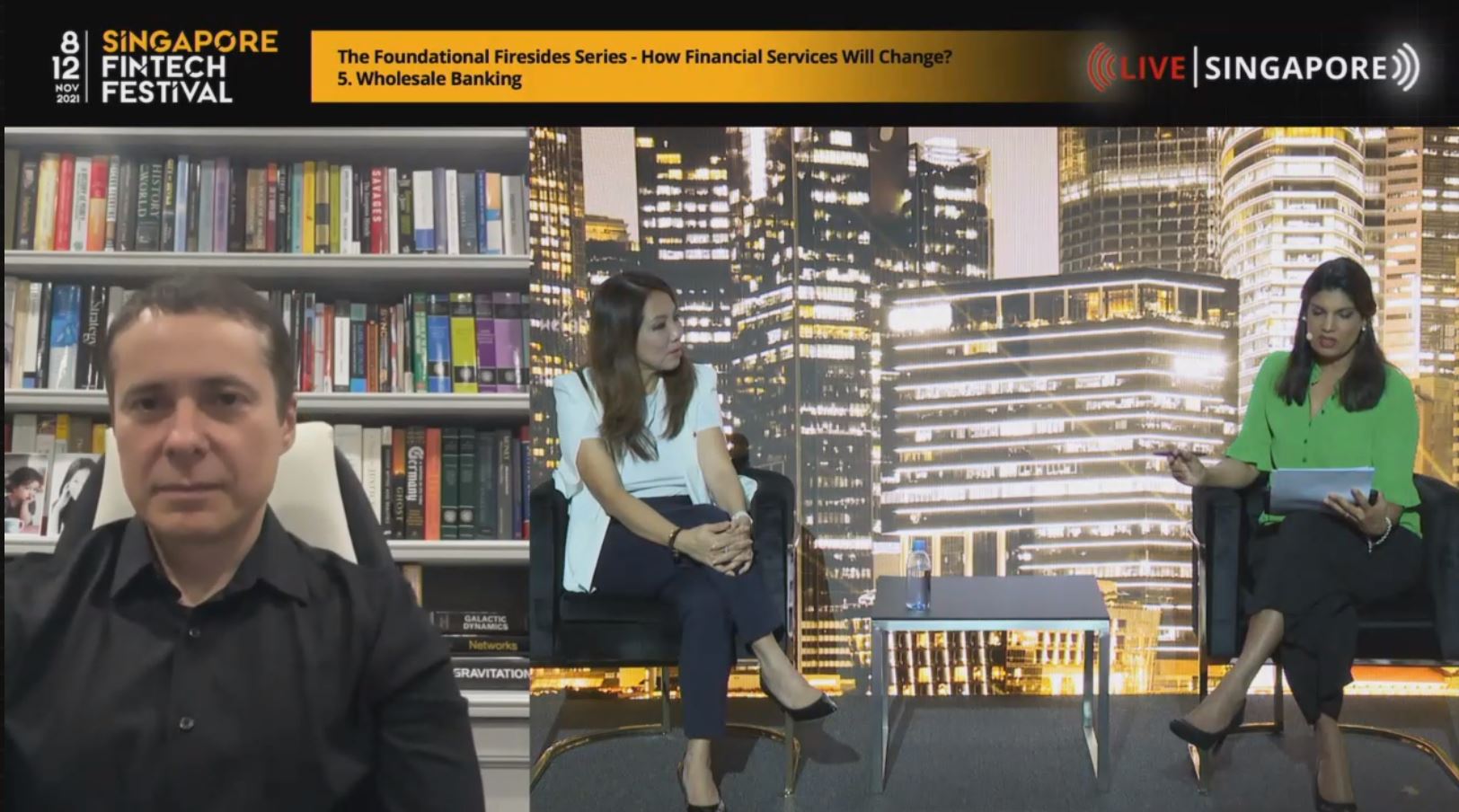The buzzword “Web 3.0” saturates the air at this year’s Singapore FinTech Festival (SFF).
What does it really mean? It refers to the next stage of the web evolution that would make the internet more intelligent or process information.
How can Web 3.0, or a “smarter internet” benefit consumers?
Well, when it comes to financial services, think of a seamless user experience when banking or buying insurance. You can also get personalised insights on your banking habits.
These functions have actually been integrated into our lives little by little.
If you haven’t noticed, try logging into one of our local banks and it will show you your spending habits. Web 3.0 has also enabled faster credit checks to process applications.

Industry experts from Tencent, HSBC, DBS, and JPMorgan Chase broke down the concept of Web 3.0 in two separate panel discussions at SFF, and shared its benefits and risks.
Personalised banking needs, seamless user experience
Web 3.0 is transforming the way banks interact with customers, according to the speakers.
“If we think about it, it’s really bringing the capabilities of financial institutions to the user at the place when they want it in a seamless way,” explained Forest Lin, Tencent’s corporate vice president and president of Tencent Financial Technology.
HSBC’s Nuno Matos, chief executive of wealth and personal banking provided some real-life examples to justify that. “ When we combine the insights data we have from customers’ portfolios – their investment behaviors, risk appetite – it allows us to offer hyper personalised insights to customers on a one-to-one basis.”

“Just last month in Hong Kong, we offered 22,000 different combinations of wealth advice, personalised for each individual customer and recommended exactly what they should be doing to rebalance their portfolios,” Nuno shared.
Nuno said that the bank immediately saw 10 times more conversations between relationship and literacy managers and customers to discuss wealth management.
Faster credit issuance through data insights
On the consumer lending side. Nuno said that the bank is able to rely on machine learning to extend credit to additional 500,000 customers without any documentation or proof of income.
“This is because we get the data and we are able to extend credit through the use of tech. This allows for much more options for customers and they can be much more empowered. Customers will control their data and decide who they want to share the data with,” he said.
“How do you assign a credit limit in the past? We used to wait six months to 12 months until we got to know the customer to assign a limit. Today with machine learning. we’re able to in a very few days,” Nuno said.

The HSBC executive also shared that the bank’s ATMs have machine learning abilities which helps them forecast each ATM’s cash situation, so that the machines are never out of money when customers need to withdraw cash.
“These are very good examples of how we really tap on tech to improve the experience for customers…It’s the transparency and putting the customer at the center of your proposition that really should drive what we do,” he said.
How Web 3.0 solves payments for businesses
On the industry side of things, Panagiostis Georgakopoulos (Takis), head of wholesale payments at JPMorgan Chase said in a separate panel discussion on wholesale banking that there’s been an emergence of global payment networks for businesses with the development of a smarter internet.
“Whether it’s marketplaces or whether it’s in the future connected cars or connected commerce, all of those things need a more efficient way for value movement. That can happen on a blockchain or not on a blockchain but it does require a much more efficient way to move money,” he said.

Takis noted that the real time payment networks that you see around the world now is a step in that direction. But they’re still only domestic and not cross-border yet.
“When you start thinking about the blockchain side of things, I think what we are doing with DBS and Temasek in Singapore is really the first blockchain-based multi-currency clearing network in the world, and therefore a great experiment as we start thinking about central bank digital currencies (CBDCs) in the future.”
Building trust and collaborations important for industry to grow
Speakers Forest and Nuno note the importance of finding a balance in this growing landscape, which requires building trust with consumers as financial institutions rely on their data to offer services.
To build trust with consumers, “the most important thing to have in mind is the protection of the user,” said Forest, acknowledging that Tencent is a fin services provider which is still considered new in the industry compared to banking incumbents.
Forest shared that Tencent practices some key guidelines, including telling customers what the business is using their data for and obtaining explicit consent from users on the sharing of their data.

Decentralised legalisation is not meant to replace the financial institutions, Forest said. “From our perspective. I don’t think that works because the financial institutions over the last, you know, hundreds and thousands of years have built that trust, and in the finance industry, regardless whether you’re talking about payment, investment, or credit. Trust is the key.”
Nuno acknowledged that the banks cannot do the tech advancements alone too.
“Sometimes and just to be realistic, banks and FinTechs will partner and we are seeing that a lot. We are seeing banks bringing FinTechs to their own value propositions to improve the end-to-end experience for customers.
“But sometimes we will be competitors. and that’s more than fine because at the end it is for the benefit of the consumer…Technology is an enabler in all of this. But technology needs to be with the right people and build trust, and in this world where people are more empowered with their data, are more savvy and more engaged, earning their trust will make the difference.”
Government legislation
Tan Su Shan, group head of institutional banking at DBS noted on the growth potential of digital trade documentation and its benefits.
“If governments and the different legal systems can be convinced that e-documents like trade documents can be digitised – i.e. they are put on the blockchain, immutable and transparent, and they can be permissioned-based so certain authorities get permission to access it – then it can be trustworthy. Now, if you can do that for trade, it will solve a lot of problems around fraud, around the long turnaround time for trade finance. I think it’s a great use case for international trade,” she said.

But both Tan and Takis acknowledged that there’s still some way to go before everyone adapts to the change.
“Covid-19 has accelerated all of that by probably five or 10 years, but a lot of our clients still have a long way to go…But I think that technology is reaching a level of maturity,” said Takis.
The important conversations financial institutions are currently making with regulators is around having clarity with the rules for these technologies, as well as the need for simplicity and clarity around these rules.
“The rules as they exist today retrieve a huge inefficiency in the system. And the more they’re simplified, the more we can eliminate that inefficiency and obviously new technologies can help make everything faster,” he added.
Future of banking
The future is set to contain cross border payments that are conductible round the clock, at low costs, the banking veterans said.
“So five years out, I do believe that blockchain will enable a lot of cross border payments today. Right now, some parts of it work, some parts of it are not. So if you have a weekend payment, for example, it might not settle for a couple of days. It’s not 24/7. Also different countries have different holiday times, So with the blockchain and smart contracts it’s 24/7,” said Tan.
Takis agreed. “Consumer payments are going to be 24/7, going to be invisible to consumers, and are going to happen at virtually zero costs. At the same time, I believe that government regulations, for better or for worse, are here to stay.”
“So I expect a lot of the same control, especially around wholesale interbank and larger state payments to look not too dissimilar to today. They may be blockchain-based but the government’s are going to continue to put all of the control that they have around them as they do today,” he said.

“I think regulators are, I would say, a little bit anxious. They see a lot of innovation happening from Asia, whether it be Singapore, which creates a lot of conversations in Europe with the European Central Bank, and obviously in the US. But the situation is different, their use cases are different and I think there is a little bit of a fear of missing out but there’s no clear strategy and direction, yet.”
Tan said that it’s all about finding a middle ground in this tech innovation growth space.
“It’s trying to find that happy medium – how do you balance both? Right, for the near term and the long term. And also, you’re not going to move from web 1.5 to two to three in a hurry, you’re going to have to be toggling both, managing what’s here and now, and managing what’s in the future. How do you find that happy balance, that’s a massive challenge for everyone.”
Tan pointed out that as much as the virtual world could have no boundaries, the physical world that we live in has governments and geographic boundaries.
“You have to, you know, physically be where those regulations and boundaries are and therefore abide by those rules.”
Get $20 off your order on VP Label when you checkout with Pace and the code PACEVP20 (min spend $80). Discover and shop exciting homegrown brands now:
Featured Image Credit: Singapore FinTech Festival








